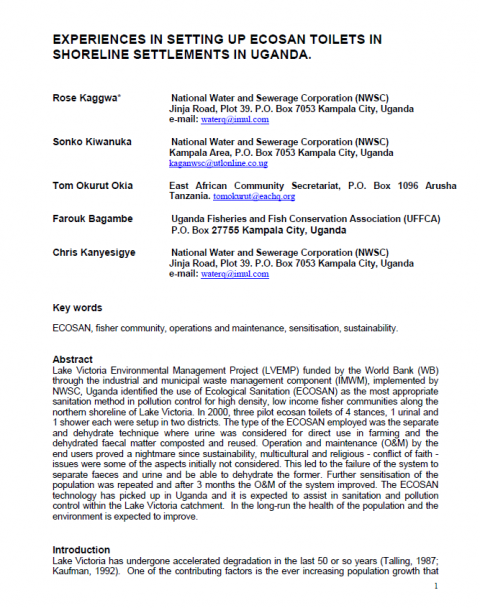Experiences in Setting Up Ecosan Toilets in Shoreline Settlements in Uganda
Kaggwa, R., Kiwanuka, S., Okurut Okia, T., Bagambe, F., Kanyesigye, C. (2003)

Published in: 2003
Author:
Kaggwa, R., Kiwanuka, S., Okurut Okia, T., Bagambe, F., Kanyesigye, C.
Uploaded by:
SuSanA secretariat
Partner profile:
common upload
5829 Views
34 Downloads
Content - Summary
Lake Victoria Environmental Management Project (LVEMP) funded by the World Bank (WB) through the industrial and municipal waste management component (IMWM), implemented by NWSC, Uganda identified the use of Ecological Sanitation (ECOSAN) as the most appropriate sanitation method in pollution control for high density, low income fisher communities along the northern shoreline of Lake Victoria. In 2000, three pilot ecosan toilets of 4 stances, 1 urinal and 1 shower each were setup in two districts. The type of the ECOSAN employed was the separate and dehydrate technique where urine was considered for direct use in farming and the
dehydrated faecal matter composted and reused. Operation and maintenance (O&M) by the end users proved a nightmare since sustainability, multicultural and religious - conflict of faith - issues were some of the aspects initially not considered. This led to the failure of the system to separate faeces and urine and be able to dehydrate the former. Further sensitisation of the population was repeated and after 3 months the O&M of the system improved. The ECOSAN technology has picked up in Uganda and it is expected to assist in sanitation and pollution control within the Lake Victoria catchment. In the long-run the health of the population and the environment is expected to improve.
Bibliographic information
Kaggwa, R., Kiwanuka, S., Okurut Okia, T., Bagambe, F., Kanyesigye, C. (2003). Experiences in Setting Up Ecosan Toilets in Shoreline Settlements in Uganda.
Filter tags
English Faeces or faecal sludge Peri-urban Sub-Saharan Africa Urine Urine diversion dehydration toilets (UDDTs)















